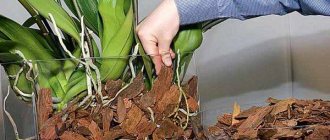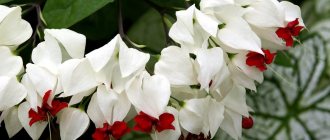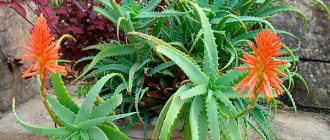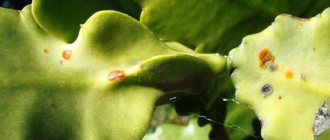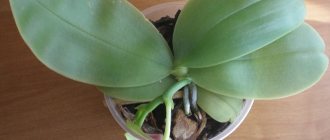The tropical beauty orchid has long settled in Russian apartments.
In general, this flower can hardly be called capricious to care for. But sometimes the orchid shows its southern character and refuses to bloom. Dear readers!
For you, we have created communities on social networks in which useful articles and interesting ideas are published several times a day! Subscribe and receive useful content in a convenient format! In today's article we will look at the reasons why an orchid does not bloom, and also look at various ways to stimulate the flowering of this plant.
Before we start stimulating flowering, let’s figure out what conditions an orchid needs to produce a peduncle.
Requirements for the conditions of keeping an orchid for the appearance of an arrow:
- A large amount of diffused light. Your green pet should receive at least 12 hours of sunlight per day. Otherwise, the peduncle will freeze and will not release a bud.
- Comfortable temperature. During the day, the orchid needs to maintain the temperature at +25 degrees. At night the temperature should be at least 5 degrees lower. If you do not achieve a difference between night and day temperatures, the peduncle may freeze in development.
- Regular watering as the soil dries out. A competent watering regime is the best way to force the arrow to release.
- High humidity levels. Also, do not forget to spray the flower from time to time.
- Proper diet. An orchid needs potassium and phosphorus to bloom. And the best option is special fertilizers for orchids. These, for example, are produced by the Agricola company.
Why does an orchid refuse to bloom?
So, you have provided the orchid with all the necessary growing conditions, you are caring for it in accordance with the rules, but there is still no flowering. This may be the case.
The absence of a peduncle is due to a violation of the conditions of keeping and caring for the flower.
Lack of lighting and irregular watering with cold water lead to no flowering.
In addition, the absence of flower stalks is affected by incorrectly selected temperature conditions, as well as the application of the wrong type of fertilizer or the absence of any fertilizing at all.
ON A NOTE. A cramped or too spacious pot and uncomfortable humidity also affect the growing season of the orchid.
Features, principles of content
Unlike other indoor plants, the maintenance of an orchid should be as close as possible to natural conditions. The root system is located close to the surface; instead of soil, a filler made of tree bark, expanded clay, mineral wool, and artificial materials with the addition of sphagnum is used. The following factors are important for development and growth:
- moisture saturation mode;
- maintaining air temperature;
- thorough lighting of the plant and its roots (orchids are bred only in transparent glass or plastic pots);
- feeding
When do orchids usually bloom (time)
Each plant has its own life cycle. The implication is that the flowering and dormant periods occur at approximately the same time. Orchid in this case is no exception.
Despite the fact that the flower grows at home, it still follows the vegetation mechanism laid down by nature.
Orchid blooms in autumn. At this time, in nature there are strong fluctuations between day and night temperatures (up to 10 degrees, from 15 to 25).
On average, a peduncle is formed within 60-90 days, but this period can be significantly accelerated if proper conditions are created.
What fertilizers activate the kidneys
As you know, flowers appear from buds. In order for an orchid to bloom luxuriously at home, it is necessary to lay the foundations for future flowering.
This is not a one-time process; different types of nutritional mixtures will have to be added in several stages.
Let's look at them all:
- Nitrogen-containing liquid compositions. Nitrogen should be used as a nutrient during the first watering after flowering. In this case, the feeding procedure is not carried out for the next 15-20 days.
- Potassium-phosphorus liquid preparations. Used several times during the period from the appearance of the first buds to the fall of the last petals.
- Special mixtures “for orchids”. For example, from the Forte company. Such complexes contain an optimal balance of micronutrients specially selected for orchids.
How to water orchids to bloom
Watering is the main agrotechnical activity when caring for plants. Proper hydration will help bring flowering closer.
You need to water the flower with warm, settled water. You need to pour water carefully so as not to flood the outlet.
In general, watering an orchid should imitate the weather in the tropics. Therefore, sometimes it is useful to take a warm shower. But there is no need to be too zealous, since abundant watering does not encourage the orchid to release a peduncle.
If the arrow stubbornly does not want to appear, then watering should be reduced, or even stopped altogether for a while. After the appearance of the peduncle, watering is restored gradually. There is no need to pour a lot of water at once.
Periods
The entire flowering process is divided into several periods:
- Vegetation. The period begins at the moment of formation of a new shoot. Not only the leaves grow, but the root system also actively develops.
- Peace. Peduncle growth and new bud buds.
- Bloom. Formation of buds and their opening. This period takes a lot of energy from the plant.
- Rest.
- Active vegetation. With proper care, this phase ends with repeated flowering.
What fertilizing is needed for an orchid to produce a peduncle?
No less important is the issue of orchid nutrition. If the fertilizing is chosen incorrectly, then flowering may not occur. The orchid, instead of releasing a peduncle, will direct all its forces to the formation of leaves or roots.
You can avoid this and make a flower stalk appear by organizing proper nutrition. The plant must be fed with a mixture of potassium and phosphorus fertilizers.
And the best option would be to use liquid complex formulations designed specifically for orchids.
Feeding should be carried out at intervals of 1-2 times a month. Moreover, the application of fertilizer must be completed before flowering begins.
And be careful not to use products containing nitrogen. It causes an increase in green mass and inhibits flowering.
Products and fertilizers
Orchids need special feeding products that will help the capricious plant ensure flowering. For this to happen, the orchid must have intact foliage and a healthy root system.
Caring for a plant includes feeding it with nutrients and microelements. The most popular and effective means of feeding orchids are:
- "Pokon"
- "Blank sheet";
- Agrecol;
- "Magic Grow";
- Greenworld;
- and "Flora".
"Pokon"
A universal remedy in sticks that is suitable for any epiphytes . Such sticks gradually dissolve under the influence of light and heat over several days, providing the plant with the necessary substances for up to three months in a row. After this, you can use the next stick.
"Blank sheet"
It has a balanced set of elements that provide the orchid with immunity to diseases and promote the appearance of new shoots and flowering shoots.
Agrecol
The effect of this vitamin complex is one hundred days - it is for this period that the plant will be provided with a complete mineral supplement that promotes the harmonious flowering of the orchid.
"Magic Grow"
A distinctive feature of “Magic Grow” is the versatility of the complex, suitable for almost all types of flowers. Guarantees the full development and flowering of the plant for three months, which is the nutritional complex.
"Greenworld"
An excellent universal product that provides ornamental flowering plants with a full range of micronutrients.
"Flora"
Universal liquid fertilizer , which is based on a natural component - an extract from vermicompost.
Important! Experts do not recommend fertilizing immediately after purchasing an orchid, replanting it, or plant disease.
How to make an orchid bloom: step-by-step instructions
Now let’s look at a step-by-step algorithm for making a plant produce a peduncle.
ON A NOTE. All of the listed agrotechnical measures are carried out strictly within the framework of shock therapy. They cannot be kept in such conditions permanently.
Step 1. Provide an artificial temperature difference. To do this, we move the pot to where there will be a difference in night and day temperatures of 7 degrees. For example, a glazed balcony or a north window.
But check that there is no draft.
Step 2. Artificially shade the flower. At this stage, you need to change the lighting mode to “shock” your green pet.
Step 3. For 10-20 days, we completely stop watering or change the moisture regime. For example, instead of watering once a week, water once every 2 weeks.
IMPORTANT! Don't do all the steps at once. Carry out only one method of “shock therapy”. If one does not work, then let the plant gain strength and move on to the next one.
Another fairly effective algorithm to make a plant bloom.
Step 1: Stop adding water for 10-15 days.
Step 2. Move the pot to a dark closet.
Step 3. After a week, provide abundant watering and fertilizing with liquid potassium-phosphorus fertilizer.
Step 4. Move it to a windowsill or balcony where there will be a temperature difference.
The peduncle will appear after 15-20 days.
What affects the flowering of an orchid at home?
As beautiful as the orchid flower is, it is also capricious when grown at home.
In order for an orchid to bloom profusely, it needs good care.
But if you bring the climate closer to natural conditions, you can observe flowering in several periods. To do this, you should perform and know a number of factors . Let's take a closer look: what to do to make an orchid bloom profusely?
Flower age
What to do to make orchids bloom magnificently and beautifully again? Before you wish an orchid to bloom , you need to know a little about its age. If the flower is grown with your own hands, then the signal for flowering will be the age, which varies from 1.5 years to 3 years. It is during this period that the plant reveals its potential.
The duration of the period is explained by the type of flower and the condition of its maintenance. During this period of time, up to 5-8 adult leaves should form.
Flowering too early can lead to death . Since the plant will not have time to accumulate strength. When buying orchids in a store, you should pay attention to the presence of adult leaves.
Plant location, proper lighting
The southern part of the house is the most optimal location for an orchid. At the same time, the plant requires shading from direct rays.
When buds form, it is no longer advisable to move the pots even a few centimeters. Not to mention their turn. All rearrangement procedures can be performed only when all open flowers have formed .
This usually lasts 10 days. Then any corner of the house can be decorated with blooming clusters of flowers. The plant is not afraid of partial shade during this period.
When buying an orchid, during the formation of flower stalks, you should notice the side of the pot that faces the light. Install the houses in the same position. This will help him adapt in a short time .
Flowering time can come at any time of the year. The main thing here is to provide the plant with enough light. In winter and autumn, you will need artificial lighting .
Important! Use phytolamps as lighting devices. They have the ability to scatter light. And what is very important is that they do not make the air space near the flower dry.
Ambient temperature and humidity
Lack of light does not allow the orchid to bloom. And the buds that appear suddenly dry out and fall off . Some gardeners mistakenly think that the entire plant needs artificial light.
Actually this is not true. It is enough to illuminate only the upper part of the peduncle. Daylight hours should be 10-12 hours.
The ambient temperature in the room plays a significant role. Its best parameters during the day are from 20 to 24 degrees C, at night: 15-18. When the difference is within 5-6 degrees.
In the summer season, the orchid can be taken out to the balcony , where it will receive a natural temperature difference. It is the difference that makes the plant bloom.
It is necessary to constantly monitor the temperature in the apartment.
In winter, you can equip a mini refrigerator . Use a box, for example, a shoe box, and fence the pot off the outside of the window sill.
The temperature from the window will be lower than in the room. These procedures should be continued at night for 10 days.
Orchids sitting in pots receive enough moisture from the soil . So you don't have to worry about humidity.
But specimens grown epiphytically, that is, on bark, need it. And also those with weak roots. To do this, several methods to obtain the desired humidity:
- Place vessels with wet expanded clay;
- Container with water;
- Spray with hot water heated to 35 degrees;
- Install a humidifier.
A good microclimate is provided by flowers standing nearby.
Watering mode
At the time when the buds are pouring, watering should be moderate. Re-irrigate after the substrate has completely dried . After all, in nature, flowers prepare for pollination during this period.
The insects that do this job do not fly in rainy weather . Therefore, you should also refrain from spraying.
Use well-settled water for irrigation and heated to 35 degrees C. In nature, monsoon rains heat up to exactly this temperature. You can use defrosted water after turning off the refrigerator.
Excess moisture can have a negative effect on the bud; it will simply wither and fall off.
Worth knowing! Before opening the flower, it is better to underwater than to overfill.
Always connect your actions with natural phenomena , then there will be no problems with flowering.
Some varieties of orchids like a dried substrate during opening and flowering. It is better to water in the morning; by evening the substrate should dry out.
Some species require re-watering already on the third day, others after a month. Leaves can serve as a signal for irrigation . They become visually wrinkled. A day after the next watering, you can notice that the leaf has straightened out and the wrinkles have disappeared.
In winter, place the flowerpot on foam plastic so that the lower layer of roots from the window sill does not become overcooled.
The pot of orchids is immersed in a container of water for 10 minutes so that all roots have access. Next, the water should be poured out of the pan or a flowerpot should be used to drain excess liquid.
Correct fertilization scheme
In nature, orchids receive nutrients from the air and dew drops. Therefore, at home you can spray bait or add it in liquid form:
- To prevent the plant from getting chemical burns, the plant is watered 2 days before applying fertilizer;
Not in all cases the orchid needs to be fed. - The solution should be warmer than room temperature;
- Reduce the suggested dosage according to the instructions by half;
- Dip into the nutrient solution for 15 minutes and remove to dry;
- After spraying, inspect the leaf axils, if drops have collected, blot with a napkin or toilet paper.
Avoid drafts and direct sunlight after procedures.
How to get multiple arrows
In some cases, you can get several arrows on one copy at once.
Firstly, to do this you must adhere to all the rules for caring for orchids.
Secondly, as soon as flowering ends, cut off the dried old flower stalks to the top bud. Treat the cut area.
A new arrow will appear from it, and another one, as usual, from the leaf sinus.
As a result, you will have an orchid with 2 peduncles.
REFERENCE. Don't be upset if you did everything according to the instructions, but only got one peduncle. The number of shoots depends on many factors. Including, from genetics, the age of a particular specimen, the condition of the roots, etc.
Reader Questions
Is it possible to shorten the rest period?
With intensive care this time can be reduced. But in this case there is a risk of disrupting the natural biological species rhythm and exhaustion. The process quickly becomes irreversible and in most cases the plant does not live long.
How to care for a plant if it has just put out an arrow?
Let's find out in more detail how to properly care for an orchid with a newly grown arrow. As the arrow begins to form:
- Stop nitrogen fertilizing and switch to phosphorus and potassium fertilizers;
- Organize watering;
- Provide sufficient illumination of the roots and peduncle.
How to make an orchid's arrow grow upward
Those specimens whose peduncles grow vertically have a special charm. This indicates the high skill of the florist.
Here are some recommendations on how to make the peduncle grow upward, and not sideways.
As soon as the arrow grows to 20 cm, fix it with a stand in a vertical position.
At first, the peduncle is green and flexible, but you still need to carry out the procedure very carefully so as not to break the arrow.
As it grows, continue to fix the peduncle on the support.
Use wide string or tape to avoid damaging stems and shoots.
In addition, keep in mind that in natural conditions, flower stalks grow horizontally. Therefore, turn the orchid pot from time to time. The arrow will reach towards the sun, and this way you will make it grow vertically upward all the time.
Expert advice on stimulating phalaenopsis flowering
When an orchid refuses to bloom, there is a great temptation to use some kind of hormonal stimulant - for example, cytokinin paste. But it is better to refrain from using such means:
“There is no need to smear the axillary buds of phalaenopsis with cytokinin. In most cases, the lack of flowering is due to a lack of light, and hormones in such conditions only worsen the situation. Good light, correct temperature conditions and moderate irrigation - and the phalaenopsis itself will bloom regularly and profusely.”
K. Suprun, florist with 22 years of experience, orchid collector
What stimulants can be used
Sometimes it happens that just agrotechnical measures are not enough for flowering. In this case, it is necessary to use stimulants.
Succinic acid is an effective stimulant. For 1 liter of water you need 4 tablets of the drug.
To stimulate flowering, the pot is placed in a prepared succinic acid solution overnight. This procedure is carried out regularly every 7 days.
You can also use cytokinin paste to force the flower to produce a peduncle.
But experienced flower growers advise not to get carried away with stimulants. Succinic acid will be quite enough.
The fact is that stimulants weaken the orchid. She spends all her energy on flowering. This undermines her immunity, and she becomes easily vulnerable to diseases and pests.
You can use both store-bought drugs and products prepared according to folk recipes.
ON A NOTE. Store-bought stimulants are much more effective, since they contain a higher concentration of the main active ingredient.
Types of fertilizers
Traditionally, all fertilizers are divided into two groups: organic and mineral.
Organic matter is the waste of birds (pigeon, chicken droppings) and farm animals (manure). Usually an aqueous solution of rotted horse manure is used. But this is not always feasible. At home, the easiest way to feed orchids is with complex mineral fertilizers. Today, flower shops offer a good selection of compositions. From time to time you can turn to folk and specialized remedies. Their characteristics are presented in the table:
| Fertilizer type | Name and composition/purpose | Method of preparing the working solution and applying |
| Mineral fertilizers | Agricola Aqua , Pocon, Bona Forte , Flower Paradise , Fasco Complex preparations, including three main macroelements (nitrogen, phosphorus, potassium), microelements, amino acids in the concentrations required by plants | Detailed information on the preparation of the solution, dosages and methods of feeding is indicated in the instructions for the drug |
| Folk remedies | Banana peel Contains potassium, phosphorus, calcium, amino acids | The peel of one banana is poured with a liter of warm water and left for a day in a dark place. Water at the root, having previously diluted the nutrient solution with water 1:1 |
| Potato peelings Contain potassium, magnesium, nitrogen, phosphorus | Raw peelings are poured with boiling water, cooled, and filtered. Water at the root | |
| Garlic infusion is rich in vitamins and phytoncides that kill phytopathogens | 2 cloves of garlic are crushed, pour in 2 liters of water, leave for a day, filter and water at the root | |
| Sugar and yeast Sugar glucose and B vitamins contained in yeast are excellent flowering stimulants | 10 g of dry yeast (bag) and 3 tablespoons of sugar are diluted in 10 liters of warm water, left for 2 hours. Pots with plants are placed in the bathtub and watered abundantly | |
| Specialized means | Succinic acid Reanimation after stress, regeneration in case of damage, stimulation of leaf growth, root formation, flowering, soil improvement | The tablet (sold in pharmacies and gardening stores) is crushed and dissolved in a small amount of hot water. The resulting solution is added to 500 ml with water. Used for root and leaf irrigation, root treatment during transplantation |
| Cytokinin paste A hormonal agent that accelerates the appearance of inflorescences and children | In the spring, after removing the covering scales, the paste is applied pointwise to the waiting buds of the peduncle using a toothpick or a cotton swab. At the same time, the plant is fed with nitrogen. After 2 weeks the bud begins to grow | |
| B vitamins : B1 (thiamine) – stimulates root growth, accelerates flowering, increases flower size; B3 (nicotinic acid) – reanimates, accelerates flowering and the formation of new shoots; B6 (pyridoxine) – increases immunity, facilitates adaptation; B12 (cobalamin) – improves oxygen saturation, promotes the development of new flower stalks | Use a solution of 1 ampoule of any vitamin and a liter of water for watering and spraying once a month. |
There is a wide range of products on sale in different forms and volumes of domestic and foreign production.
Specialized fertilizers for orchids are preferable to universal complexes for flowering indoor plants, as they contain reduced concentrations of elements that can burn the roots.
Why does the shoot freeze and not grow?
The freezing of the escape is associated with a violation of the conditions of detention:
- lack of sunlight;
- there is no difference between day and night temperatures;
- improper watering;
- too dry air in the room, lack of spraying or improper spraying;
- lack of potassium and phosphorus in the diet.
IMPORTANT! A combination of factors usually leads to the fading of a peduncle, but the harmful effects of any one of them cannot be ruled out.
Stimulation of flower stalk growth
A plant with 5-8 leaves is ready to bloom. But how to increase the growth of an orchid? To make flower stalks grow more actively, growth stimulants are used, i.e. fertilizer :
- In order for the orchid to accumulate strength for the period of lush flowering, fertilizing must begin from the moment of active vegetation of leaves, peduncles, and buds;
- As soon as the first bud opens, fertilizer is declared taboo;
- The plant needs nitrogen (N), potassium (K), phosphorus (P) and other trace elements;
- Nitrogen is the leader for increasing green mass;
- When a flower stalk appears, more potassium and phosphorus are added to the bait. Potassium stimulates the formation of buds, increases the plant's immunity, and is actively involved in metabolism. Phosphorus stimulates growth, the flowering process, and forms the root system;
- Additives in the form of magnesium and boron allow the main components (N, P, K) to be absorbed;
- Acidity should correspond to 5.5-6.5 pH. You can check it with indicator plates. Deviations from the normal level lead to the fact that the main components will not be absorbed. This is in the case of high acidity. As the alkaline environment increases, boron, iron, and copper are not absorbed.
Rules for feeding with drugs
During active growth, liquid NPK fertilizer must be applied in a ratio of 8:3:5.
When a peduncle appears, the dosage of NPK changes to 2:6:6.
Feeding is carried out every 2 weeks if activity falls in the summer. In winter, the gap between meals is 30 days.
Fertilizers should be alternated between root and surface fertilizers. Frequency will prevent the roots from getting burned. During spraying, reduce the dosage from the instructions by half, for complex fertilizers - by 3-4 times.
Newly transplanted plants are not fed, since the substrate contains nutrients .
Recommended drugs
How to feed orchids? Flower growers recommend using liquid fertilizers . The most popular of them:
- “Greenworld” (Germany) – before use, shake and dilute according to the instructions for the root system with 10 ml per 3 liters of water, in case of spraying, reduce the dosage by 2 times. The solution is brown and odorless. When spraying, remove excess moisture from growing points;
- "Bona Forte" (Russia) - complex fertilizer. Stimulates re-blooming;
- "Kemira Lux" . Judging by the reviews of flower growers, it occupies a leading place. There are no complaints about him;
- Substral , Etisso and BioEkor also have quite a following;
- "Flora" . Contains natural ingredients. The fertilizer is used for foliar feeding. The container is equipped with a sprayer.
Advice! Look at the label for the amount of NPK in the solution. So that you can decide at what stage to apply the fertilizer.
Common mistakes
Let's look at the most common mistakes that gardeners make when they try to encourage an orchid to produce a peduncle.
- The frequency and abundance of watering increases. Before flowering, the amount of water must be reduced, or even stopped altogether. Such stress will cause the orchid to release a flower stalk.
- No temperature changes. The difference between day and night temperatures should be at least 5-7 degrees. Only then will the orchid throw out an arrow on which buds will subsequently appear.
- Abundant feeding. There is no need to overfeed the flower. 2 feedings per month before the period of active flowering are enough. And these fertilizers must be potassium-phosphorus. And ideally, it is necessary to use liquid complex formulations.
- Use of strong growth stimulants. A healthy orchid will bloom without stimulants. But their uncontrolled use can only harm your green pet.
Errors leading to inhibition of phalaenopsis flowering
Long-term absence of flowering in phalaenopsis orchids is often caused by mistakes made by gardeners:
- Frequent and abundant feeding. Orchids should not be overfed, especially with nitrogen-containing fertilizers. The fertilizing needs of these plants are much lower than those of any others.
- Failure to maintain a balance between humidity, air temperature and illumination. These three conditions must be clearly regulated. At high temperatures, there may be more light and moisture; in a cool apartment, watering and spraying should be rare, but the amount of light should be sufficient.
- Abuse of stimulants. Even beneficial vitamin supplements should be used in moderation. This is especially true for hormonal drugs, which in case of overdose cause the opposite effect - not stimulation of growth and flowering, but inhibition.
Flowering is also inhibited by such circumstances as frequent changes in the location of the orchid in the apartment, replanting or treatment with potent systemic pesticides.
Answers to frequently asked questions
In conclusion, we provide a list of answers to the most frequently asked questions regarding the flowering of this flower crop.
What is the peduncle of an orchid?
A peduncle is a root-like shoot on which flowers bloom.
Why force a plant to bloom at all? Besides the decorative functions of the flower?
Flowering is an important part of the plant’s life cycle, and “babies” appear on the peduncle of the orchid, with which this flower crop then reproduces.
How to feed an orchid for abundant flowering?
Buy a liquid complex preparation containing potassium, phosphorus, and humic acids. Add to irrigation water twice a month. This is quite enough.
Why did the plant throw out an arrow, but it stopped growing?
This means that the conditions of detention do not meet the requirements. Check if you are caring for the flower correctly.
Where to put a flower pot?
Ideally, the pot should be placed in a cool, draft-free place, where the air temperature drops at least 5 degrees at night. You can also hide it in a closet to force the plant to produce a flower stalk.
Fertilizer for flowering
One-time
To stimulate one-time flowering of an orchid, proven and effective preparations should be used. These include “Amulet” and “Bud”.
- “ Amulet ” puts the plant into a state of accelerated growth due to the additives contained in the vitamin cocktail. This improves the vegetative growth of the epiphyte. To achieve a positive effect, you should carefully observe the dosage, violation of which is detrimental to the orchid.
- “ Bud ,” due to the sodium salts and mineral acids it contains, is a more universal product used for foliar and root feeding.
Permanent
To ensure permanent flowering of the orchid, it is recommended to use only one selected type of fertilizer, changing which can negatively affect the health of the plant.
Flowering is achieved by creating a stress effect . For this purpose, the plant is moved to a cool zone where the temperature does not exceed 15 degrees Celsius. A healthy plant will easily endure such a test and produce flowers.
In the future, it is worth choosing a certain type of fertilizer depending on the type of flower and the place where it is located, carefully following the instructions, avoiding flooding the roots of the plant with water and avoiding too high a concentration of the selected fertilizer.
Secret 2 - Lighting and Placement
In order to obtain abundant, long-lasting flowering, the orchid must be properly cared for. It is best to place a pot with an orchid on a south-facing window, but on hot sunny days it should be shaded, avoiding direct sunlight. After the first buds appear on the flower, the plant should not be touched or moved at all. This may entail a complete reset of all buds. If you really want to place a blooming orchid in another place, wait until all the flowers are fully open. This is observed for ten days. After all the flowers have opened, you can place the pot in any place, even semi-shaded.
After you have bought a plant, pay attention to which side its flower stalks are formed on. It was this side that was directed towards the light. When you bring it home, place the pot in the same way. This will help the plant quickly get used to the new place and prevent the buds from dropping. The orchid does not have a specific flowering time; it can bloom at any time of the year. The main factor is the availability of the necessary lighting, which directly affects the size and color intensity of the flowers.
In winter, the flower must be illuminated with special phytolamps, which have the ability to create diffused light and not dry out the air. If there is insufficient light, the flower may not bloom at all, and the buds will dry out and fall off. Install phytolamps so that most of the light falls on the top of the peduncle. The lighting period must be at least 12 hours.
Nuances of plant care before, during and after flowering
It is no secret that the orchid is a capricious plant and requires compliance with all the rules of care:
- Care before flowering. During the dormant period, before the buds open, it is necessary to regularly water, maintain temperature conditions, apply fertilizers and monitor the amount of light and humidity levels.
If an orchid was transplanted, then immediately after that it is watered with boiled water with the addition of magnesium or potassium to replenish it. It is best to immerse the container with the orchid in the prepared solution and let it sit for half an hour. In the future, watering is carried out immediately after the soil dries. - During flowering. After the buds open, the orchid is well moistened by irrigating the aerial roots with warm water (slightly above room temperature).
If there is not enough moisture, the peduncle will dry out and die. The room where the blooming orchid stands is regularly ventilated (avoiding drafts), and the air is humidified. You can use special equipment or place a bowl of water next to the orchid. As soon as the buds open completely, watering is reduced. - After flowering. Old flower stalks are cut off to allow new ones to appear. However, the arrows must dry well, otherwise the risk of the orchid getting sick increases. It takes a little time for the plant to recover and bloom again. Therefore, immediately after flowering, fertilizers are applied so that the plant gets stronger and gains strength to bloom again.
